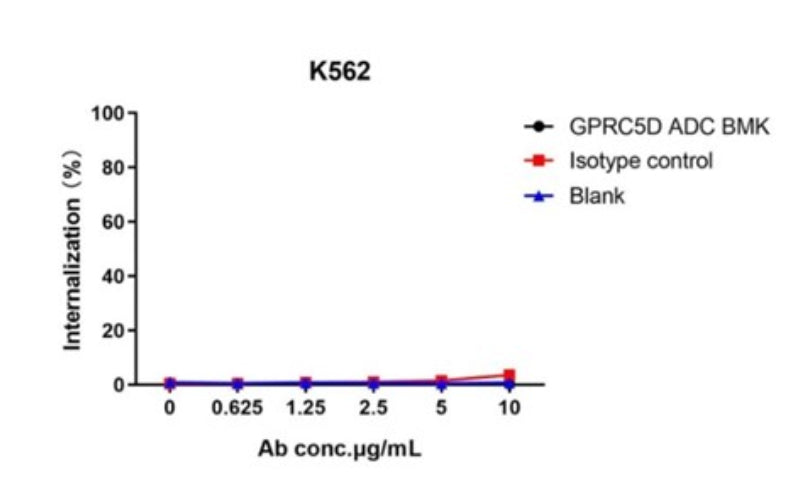Antibody endocytosis efficiency test reagent 一、pH-sensitive IgG labeling reagents plus


The fluorescent signal from GPRC5D ADC BMK-UA070080 conjugate is only detected in GPRC5D positive cells (K562-GPRC5D stable expression cell line), indicating specific internalization.
pH sensitive IgG labeling reagents provide an easy solution to measure internalization activities of antibodies. This reagent utilizes a pH-sensitive fluorescently labeled Fc binding protein that binds to IgG antibodies from various species, resulting in the formation of a fluorescently labeled antibody-reagent complex. After antibody internalization, the surrounding pH becomes acidic and significantly enhances fluorescence signal of antibody-reagent complex. The fluorescence intensity can be used as an indicator to determine the internalization activity of antibodies. By measuring the strength of the fluorescence signal, researchers can assess the efficiency of antibody internalization into cells. This information is crucial in understanding the cellular uptake mechanism of antibodies and assessing their efficacy in targeted therapies or diagnostic applications. Additionally, monitoring the fluorescence intensity can also provide insights into the kinetics of antibody internalization, helping researchers optimize experimental condition and improve the design of antibody-based drug delivery systems.
This product can becan be used for human IgG1, IgG2, IgG3, IgG4, rabbit IgG, mouse IgG1, IgG2a, IgG2b and IgG3 and can be detected with Flow cytometry FITC or AF488 filter.
| Catalog Number | Name |
|---|---|
| UA070080 | pH-sensitive IgG labeling reagents plus |
二、DT3C recombinant protein
Antibody internalization efficiency detection principle & steps
principle:
DT3C (Diphtheria Toxin Fragment A and Streptococcus Protein G C1, C2, C3) is a recombinantly expressed fusion protein, which is formed by the fusion of Fragment A (toxin part only) of diphtheria toxin and 3C fragment (IgG binding part) of group G streptococcus. This protein has a high affinity with the Fc end of the antibody, and the DT3C molecules bound to the antibody enter the cell together when the antibody is internalized. DT3C can bind to any IgG type antibody, so it can be used to detect the internalization efficiency of antibodies from different species. The mAb-DT3C conjugate formed after DT3C binds to the antibody simulates the mechanism of action of ADC drugs in vitro, which helps to evaluate the internalization ability of antibodies and the release efficiency of drugs in the early stages of drug development.

- DT3C consists of catalytic (Cat), translocation (T) and Fc binding (3C) domains. The Fc binding domain of DT3C specifically binds to antibodies.
- After the mAb-DT3C coupling complex recognizes and binds to the cell surface antigen, the mAb-DT3C-antigen complex is internalized. The translocation end of DT3C is cleaved by the cell furin protease, and the catalytic domain of DT3C is released into the cytoplasm. DT3C releases toxic DT, which can inhibit the activity of EF2-ADP ribosylation, block the protein translation process, and ultimately lead to cell death.
DT3C that has not entered the cells has no cell-killing activity, so the internalization efficiency of the antibody can be evaluated based on the cell killing situation.
Testing steps:
- Preparation of mAb-DT3C conjugate: Incubate DT3C protein and target antibody at room temperature for 30 minutes to form mAb-DT3C conjugate.
- Co-culture: Add the mAb-DT3C conjugate directly to complete culture medium containing antigen-positive cells (such as tumor cells) for incubation.
- Detect internalization efficiency: Detect cell viability or cell death by MTT, WST-1, CellTiter-Glo, flow cytometry and other methods to evaluate the internalization efficiency of the antibody on the cell surface.

DT3C detects the advantages of ADC drug antibody internalization efficiency
- Wide applicability: Can bind to any IgG from different species (such as human, mouse, rabbit, goat).
- High efficiency : mAb-DT3C conjugates can be formed by incubation at room temperature for 30 minutes. DT3C can quickly release toxic DT in cells, thereby quickly evaluating the internalization efficiency of antibodies.
- High internalization efficiency: The molecular weight is smaller than that of Mab-ZAP, and the internalization efficiency of mAb-DT3C is higher than that of mAb-Mab-ZAP.
- Convenience: The internalization efficiency of mAb on the cell surface can be quickly and accurately detected by methods such as flow cytometry or fluorescence microscopy.
Note: When conducting in vitro testing, the consistency of experimental conditions should be ensured, such as cell type, cell concentration, ratio of DT3C and antibody, incubation time, etc. Sterile operations during the experiment need to be strictly controlled to avoid interference from external factors.
| Catalog Number | Name |
|---|---|
| UA070063 | DT3C (Diphtheria toxin & spg 3C domain) Protein, Corynephage beta |




